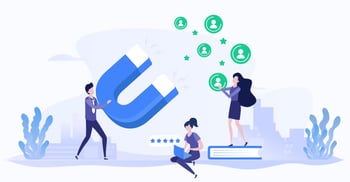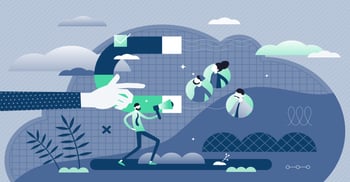SaaS Sales Funnel: A Fundamental Guide to Boosting Your Conversions for 2022
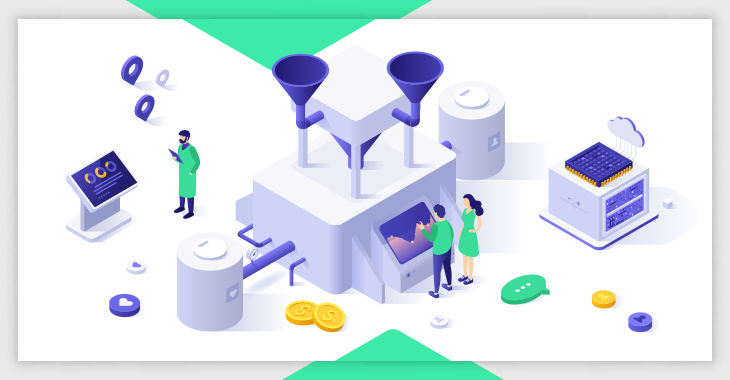
All companies that sell SaaS online know that optimizing their sales process is key to success. Implementing a strong sales funnel is even more important in a SaaS business, as in this industry, the customer acquisition process requires a more tactful approach. Yet many face significant challenges that prevent them from securing a steady revenue stream. Organizations often struggle to find leads, lose customers at the top of the funnel, or have their prospects drop off after weeks of courting them with pitches and demos. While this is not uncommon, it demonstrates that the funnel may have some weaknesses that can be easily overcome. If these challenges sound familiar, our guide will give you all the information you need to build a winning sales funnel that can tremendously help in terms of customer retention.
What is a Sales Funnel?
A sales funnel is a marketing concept that describes a potential customer's journey from prospect to paying customer. It's described as a funnel because more people enter the top of the funnel as prospects than the number that exits at the bottom. Top-of-funnel actions aim to attract leads and draw potential customers. The SaaS sales funnel helps clearly define a business strategy that moves prospects to the next stage.
Top 5 Benefits of Using a SaaS Sales Funnel
Focusing on creating an efficient and effective sales funnel can help you identify the stage at which your prospects are dropping off and not converting. SaaS developers typically focus on one goal, which is to consistently increase the number of subscriptions to boost the monthly recurring revenue. Though implementing a sales funnel might seem challenging, you need to roll up your sleeves and get things started because a strategically prepared sales funnel can turn into lead magnets and drive those subscription numbers through the roof.
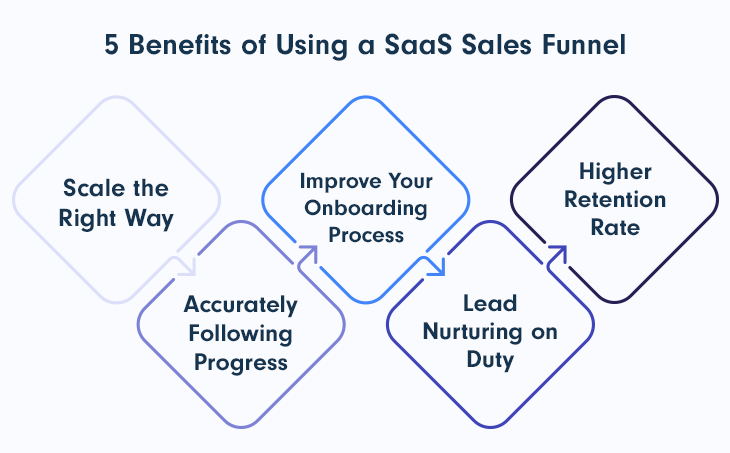
When putting a smart, goal-oriented sales funnel in place, any SaaS company will then be able to:
1. Scale the Right Way
Seeing the subscription numbers explode can certainly be a sight for sore eyes! But you definitely wouldn’t want to see it all disappear at midnight, would you? A successful company should always go after the long-term goal instead of short-lived success. Fortunately, a sales funnel gives you the tools and systems that ensure constant and substantial growth. Once you have implemented a carefully-designed process, you will be efficiently using your resources rather than over-hiring unnecessarily. With a carefully executed sales funnel, your B2B sales and marketing team will continuously and skillfully drive sales.
2. Accurately the Following Progress
If there is one thing developers love, it is data. And for a good reason. Though progress is measured in numbers, diving into analytics is challenging if you handle your growth chaotically. Of course, you might be thinking, numbers are numbers, and they might not reflect the real situation, nor will they be able to pinpoint what and where alterations need to be made. So, why bother with creating a system? With a sales funnel, you can extract data from each phase and make modifications based on that information. Then you will notice the Domino effect because once one stage is altered, it affects the entire selling process. Understanding the steps potential buyers take from first exposure to your product or service to purchase can help you guide, track and convert a prospect to a marketing-qualified lead and later on to a buyer.
Thrive with the industry’s most innovative all-in-one SaaS & Digital Goods solution. From high-performing payment and analytics tools to complete tax management, as well as subscription & billing handling, PayPro Global is ready to scale your SaaS.
Sell your SaaS globally with PayPro Global!
3. Improve Your Onboarding Process
Because 58% of customers believe having a personalized experience with a SaaS product is essential, developers see the onboarding process as a crucial step in showing their ROI, value, and positive user experiences. The rule of thumb is to make the onboarding of SaaS apps as simple and frictionless as possible. However, some products are too complicated to afford a three-step onboarding process, so it’s a delicate balance of being succinct yet thorough in your documentation and process. While there are plenty of ways to tackle this issue ( A/B testing, feature adoption goal comparison), looking into user behavior analytics to see where people are getting stuck or dropping off is something you should properly investigate. A sales funnel adapted to your SaaS business will capture these details, providing access to critical data on why users subscribe and unsubscribe. Your team can and should use that information to streamline the onboarding process, personalize it and reduce friction even more.
4. Lead Nurturing on Duty
Interesting fact: did you know that a whopping 79% of your leads will not be converting into subscribers? Even though it is disappointing given your marketing efforts, it's important to remember that it’s part of the process. If you are doing business intelligently, using a sales funnel to increase conversions, you must also engage heavily in lead nurturing. These users often need a bit of convincing in a personalized manner, and your SaaS sales team should customize their approach to meet these needs. Without a sales funnel to identify the leads that need nurturing, they would go unnoticed, and likely be a lost opportunity. By the time you realize that you are not gaining as many subscribers as you would have hoped to, you will be risking losing those marketing qualified leads forever.

5. Higher Retention Rate
SaaS is an industry that thrives on retention. Of course, winning new subscribers is always a goal (especially for a SaaS startup), but retention is very much the lifeblood of the model. Why? Simply put, it is simpler and less expensive. It’s five times cheaper to retain a customer than to attract new users. But what does SaaS retention have to do with the sales funnel? Everything! A well-planned sales funnel allows you to keep existing customers engaged in the process. And for marketers and sales reps functioning on a tight budget, the lower customer acquisition cost is always a solid argument to implement the funnel. Through loyalty programs, cross-selling and upselling, or referrals, a funnel gives you the proper means to leverage your product. You are also reducing friction by simplifying the remarketing process and building a higher customer loyalty, thereby ensuring a steady revenue.
SaaS funnels map out the path your prospects need to take to become loyal customers. Once you’ve identified any problems, you can better predict how to nurture your leads. Lead nurturing is essential in keeping the customer acquisition costs low and the customer lifetime value high, the ideal scenario for your SaaS product.
Optimizing your SaaS sales funnel can ultimately influence the customer journey so much making the difference between converting or not. It can tell you how to go above the prospects expectations and keep them close to you.
What are the Key Stages of A SaaS Sales Funnel?
People in the marketing and sales world will be familiar with the acronym AIDA: Attention, Interest, Decision, and Action. These four concepts represent the stages most prospective customers will go through. Each step represents a customer mindset and requires careful planning to create the correct messaging and take the appropriate action.
Imagine encouraging a potential buyer to buy your product before they’ve had a chance to explore or learn about it. You’d probably lose them before you could pique their interest. Take note of these four stages, which will put you on the surest path to growth.
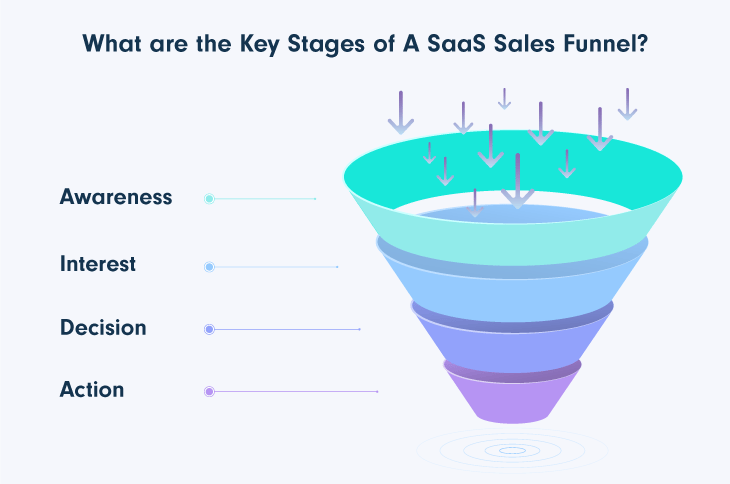
Stage 1: Awareness
During the first stage of the sales funnel, awareness is created when a lead finds out about your product or service. This awareness can come from an advertising campaign, social media posts, a Google search, or word of mouth.
Awareness happens when customers have a particular problem and need to solve it or when they encounter a product and realize that it could bring some specific value to them. Your top-of-funnel content needs to be easily discoverable so that many potential customers can access it.
This stage is like trying to impress someone on a first date. You want to make an excellent first impression and encourage follow-up contact, but you don’t want to come on too strong and scare them off.
At this point, some potential shoppers may jump right in and buy your product if the timing is right and the value is clear. Most of the time, however, they require more ‘courting’ to take the leap and make the purchase.
Stage 2: Interest
At the interest stage, your prospective customer is doing research to find the best product to resolve their problem. Your prospect is probably doing comparative analysis and thinking about several other options. You want your product to stand out as the best option.
You’ll need to provide informative content that isn’t a hard sell because too much sales talk may put off leads. The goal is to show your product as the best solution to their pain points or weaknesses. By using email campaigns, ebooks, and blog posts you will be effectively generating interest and giving more product information. Make it clear that you’re available to assist if the prospect needs any additional help or information.
Stage 3: Decision
The decision stage is where the prospect is ready to buy and may be considering a few options, including yours. At this stage, you need to make your best offer, such as a flexible pricing strategy including multiple plans, a discount code, or a free month’s subscription. Your offers need to be so irresistible that customers cannot help but choose your product over your competitors.
Here you can turn on the sales charm, but be careful not to overwhelm the prospect. You want to build a relationship based on trust. Phone conversations with sales team, targeted webinars, and sales pages work well to build this trust and convince customers to purchase your product.
Stage 4: Action
At the lower end of the sales funnel, the final stage is where the potential customer takes action and purchases your product. This is the most crucial stage, but it doesn’t end when the prospect becomes a customer. Focus on customer success and retention through continued communication, for example, a thank-you letter, excellent tech support, discount code for a paid trial, send customer satisfaction surveys, rewards programs, and other targeted techniques to increase satisfaction.
Keep in mind that even if the prospect doesn’t buy, you can still attempt to stay top of mind. This is best handled through nurture campaigns such as an email series to build long-term relationships between your business and the potential customer. This shows a real interest in the relationship and your desire to partner with them because you believe you can truly help them grow their business.
Thrive with the industry’s most innovative all-in-one SaaS & Digital Goods solution. From high-performing payment and analytics tools to complete tax management, as well as subscription & billing handling, PayPro Global is ready to scale your SaaS.
Sell your SaaS globally with PayPro Global!
9 Easy Steps to Building a SaaS Sales Funnel
Now that you understand the sales funnel and see the value in building an effective one for your own business, you can start designing a strategy that works for your SaaS services and explore the most profitable methods of acquiring customers. However, when it comes to SaaS, you will need to take a slightly different road to ensure business growth.
1. Gather Data About Potential Customers and Buying Process
The first step is to begin to gather data about your potential customers. Audience parameters need to be very clearly defined ‒ you don’t want to (and can’t) sell to everybody. Decide who would be a good fit for what you’re selling. Where are the people you feel you can truly help? Then look at the behaviors of your target audience: where and when do they search the web? How much time do they spend on particular pages? Ask them questions about their challenges, frustrations, goals, and what steps they have taken to achieve them.
Having done all of this, you can create a sales funnel aligned with your customers' needs. At each funnel stage, you’ll know what content is necessary to address their needs and what action to take to show the value of your product. You could even gain insights that help you create a better product that is more compatible with your prospects if you have the proper communication and are good at building these relationships.
2. Build Your Buyer Personas
Once you’ve gathered data on your potential customers, you’ll need to create buyer personas. These are detailed descriptions of the people who represent your target customers. Take these personas, and collate them into target groups. This will make it easier for you to personalize content, messaging, and services to meet your target audience's specific needs, behaviors, and concerns at each funnel stage. It will allow you to have a real lead magnet landing page for your campaigns.
We recommend thinking about what Clay Collins said in regard to growing a SaaS business.
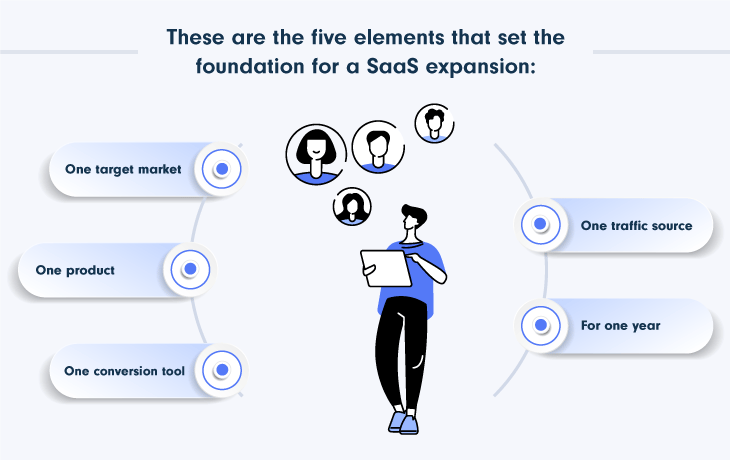
You can create as many buyer personas as you like. But when it comes to testing them or, even better, implementing them in marketing campaigns, use one of them for a set period of time, and give it time to work its magic.
3. Draw In Potential Buyers Through Lead Generation
Attracting prospects to your website is one of the first steps in the sales funnel and in the sales cycle, for that matter, so it’s important to strategize on the various ways in which you can attract potential buyers. One of the ways to do this is through lead-generation strategies.
Lead generation is a process that builds visibility, interest, credibility, and trust from a specific group of people (your potential leads). Lead generation usually falls into two categories: outbound and inbound generation.
Outbound generation is the pushing out of messages and information about your business to those who may not even know about it or have never even asked about it. This is usually done directly via sales teams in various ways.
Inbound generation is about creating campaigns and content to attract potential leads to your website and then hopefully converting them into paying customers. In the early stages of the sales funnel, you may be looking to attract customers organically at first.
So how do you do this? By offering content across your platforms with informative blogs, infographics, videos, webinars, and anything that will be of interest to your potential buyers. You can create a form or pop-up to draw in leads and work towards using ads, influencer marketing, and SEO optimization to boost lead generation.
4. Build an Effective Landing Page
Once you’ve drawn in your prospect, you want to bring them to a landing page. You should keep in mind that B2B landing pages are a different breed. Your prospects come to the page from several routes, such as through social media, blogs, SEO, or email campaigns. The goal is to align the main points discussed in the campaigns with the solutions offered on the landing page. explaining how your product can solve a problem through focused, compelling headlines and concise wording will allow potential buyers to see the value and ROI. You should also mind your CTA as this is a crucial step in the landing page and should always be kept clear and straightforward.
All landing pages are based on obtaining a commitment when prospects agree to fulfil an action in exchange for something. In B2B, you might want to go for micro-commitments such as an eBook in exchange for an email address. Don’t force your prospects to schedule a 30-minute call right from the start and try to use the landing page to capture leads and not hard sells which might scare customers away.
5. Offer Value
Now that your prospect is impressed with your landing page, it’s time to demonstrate your product’s value. For example, give them an informative ebook for their email address. One way to do this is to provide a video or an offer to sign up for an introductory webinar. By doing this, you’ll get the prospect’s contact details to continue moving them deeper down the sales marketing funnel while they feel like they are also gaining some valuable information.
When creating this content, make sure you consider your buyer persona’s typical pain points. Showing how your product will help them in a very practical way will create value and goes a long way in helping them understand what you can do for them. Creating interest by showing the best parts of your product, especially ways in which it is better than the competition will show potential shoppers that you have something to offer them that will improve their own product.
6. Utilize an Email Drip Campaign to Nurture the Prospect
Once you’ve brought your customers into the funnel and demonstrated your product’s value, you need to move them towards the final step: a sale. The best way to do this is through an email drip campaign which is a series of emails with relevant, compelling content which continues to educate and show the value of your product. This can be a delicate balancing act because you don’t want your prospect to lose interest or forget about your business, but you also don’t want to overwhelm or bore them with too many emails. Once or twice a week is usually sufficient but keep in mind your typical buyers and act accordingly.
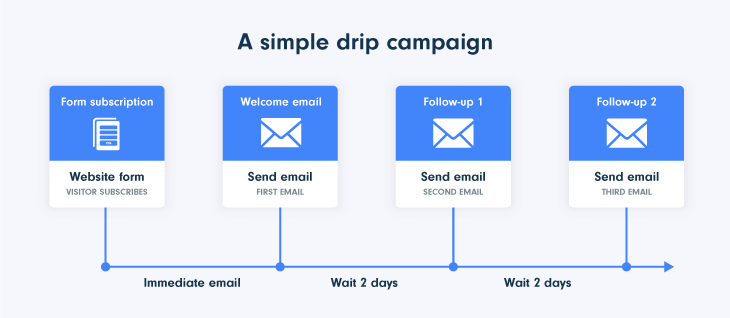
Your previous research will help you decide on the content you wish to share at this stage. Think about what the prospect wants and needs to know about your product. What are their needs at this stage, and are there any concerns you need to address? Keep re-working this campaign over time as you learn what works and what doesn’t and try to be flexible as you gain more feedback. Devote your efforts to nurture your prospects during this interesting stage so you do not lose them to the competition.
7. Close the Deal
Once you get to the end of your email campaign, it’s time to seal the deal and make the sale. This is the time to put forward your best offer to turn your prospect into a customer. You can consider giving them a free trial when they sign up, a discount code, or free shipping to further entice them.
Think about your customer experience and be sure to make the final steps to purchasing your product simple. Reduce friction by minimizing the number of steps and making signup as quick and uncomplicated as possible.
8. Keep Lines of Communication Open
Whether your prospect is converted into a customer or not, remember that the journey doesn’t end here. You will need to keep reaching out to those who have signed up and bought the product. Thank your customers for purchasing with a personalized email or a dedicated follow-up page. This will promote brand loyalty and foster word-of-mouth marketing. Keep them up to date with changes on the product and your latest promotions. By bringing them into your social media sphere and encouraging interaction with super users and the rest of your community, you can create more buzz about the value of your service or product.
By nurturing those who didn’t convert with regular emails you can still close the sale. Sometimes, a “no” is a “not yet”, which means the prospect may be convinced later on, or perhaps the timing is better for them to invest in your offering in the near future.
9. Creating Content to Complement Your Sales Efforts
Your marketing endeavors need to be aligned with each stage of your sales funnel, so you must put out different content for the top, middle, and bottom of the funnel. At the top of the funnel, focus on content that provides information on the problem your business is solving. For example, ebooks, infographics, a landing page, and a guide on how to use the product is an excellent way to accomplish this.
In the middle, you will need to show the prospect how your product can solve their problem and more than likely increase their revenue or productivity. This is best done through webinars, resource pages, customer satisfaction surveys, and educational resources that are relevant to them. At the bottom of the funnel, you must demonstrate why your product is the best in the market. You want to bring out customer reviews, demonstrations, case studies, and product overviews.
Lead magnet strategies, like white papers, free consultations, or a trial subscription, work well when your prospect is in the interest stage. Webinars can close the deal at the decision and action stages. Use a combination of your best content to nurture your leads throughout the sales journey and pay attention to any feedback you are receiving for indicators of how your product is being received.
3 Most Useful Techniques to Measure Your Sales Funnel’s Success
Understanding how to build a SaaS sales funnel isn’t everything, though. You need to test it, just like you do with your marketing strategy. So, we recommend using these three methods, including some essential SaaS sales funnel metrics to measure the effectiveness of your sales funnel.

1. Start With Business Intelligence (BI)
BI leverages software and systems to create actionable insights from data collected. For instance, in the attention stage, use your total addressable market, then narrow it down using ideal customer profiles and buyer personas. At the interest stage, look at both intent and social media data. Product data, proof of concept content, and feedback loops in the decision stage provide vital data insights.
2. Track the Key SaaS Sales Funnel Metrics
In the SaaS industry, there are many ways to monitor if your marketing strategies can efficiently scale your business, but these six key performance indicators are vital to check the success of your SaaS conversion funnel:
Sales productivity: Total revenue brought in divided by the number of sales employees
Lead Response Time: How quickly do your sales reps make contact with a lead after they express interest?
Quality of Lead Sources: Which lead sources improve the odds of getting a new customer?
Upsell/Cross-sell rates: How successfully your team is managing to up/cross-sell?
Conversion rates at each stage in the funnel: How many leads move through each stage, and how long do they spend there?
Sales forecast: Do you have enough leads entering your pipeline to meet your future goals?
3. Implement A/B testing on Different Aspects of the Sales Funnel
Another effective way to measure your marketing funnel conversion power and improve sales success is to conduct A/B split testing on different elements of your funnel. You must understand that a SaaS funnel is a work in progress. This is the kind of project you will be constantly working to optimize and improve.
Constantly performing A/B tests is a necessary step because it allows you to better understand where potential clients are getting stuck or where leads drop. And instead of redoing your own SaaS funnel repeatedly, you can easily optimize specific steps if you pay close attention to how buyers are reacting.
How Can PayPro Global Help your SaaS Business?
PayPro Global is a unified, all-in-one SaaS solution that allows SaaS, Software & digital goods developers to sell their products worldwide. While providing you with high-performing payment tools to secure fast and secure worldwide transactions and complete tax, subscription, and billing management, we also offer the support you need when it comes to analyzing your sales performance. You can gain instant access to real-time sales, marketing, and financial data collected through AI and ML-based technologies, allowing you to optimize your current strategies and operations and plan new ones.
To ensure you are getting the best of our data mining engine, we present the information gathered in structured reports which can also be customized to your exact needs. You can receive specific insights regarding the saas metrics you are interested in over a set period of time. Our goal is to give you the system you need to secure steady revenue streams and constantly identify new ones.
Additionally, PayPro Global equips your business with different subscription and sales models, anything from trials and freemiums to demos, giving you the opportunity to offer value to your target audience and efficiently draw in new customers, while taking care of your existing, loyal customers. We can help customize your pricing page, making it truly customer-oriented.
Concluding Thoughts on Building a Winning SaaS Sales Funnel
Within this world, developers that sell software online are facing significant competition. Therefore, they need to constantly apply digital marketing strategic tactics to acquire new customers. By carefully optimizing sales funnels, you can stay ahead of the game. Your efforts to open, secure, and maintain communication channels with more qualified leads should create and increase their trust in your products.
A sales marketing funnel built for SaaS businesses takes the prospect through its four stages to understand their weak points and establish that the solution provided by the developer is the one that will improve upon their product. Impulse shopping in the B2B industry is not a common phenomenon. This market segment is all about product education, referral, or cross-examination. So, make sure your sales rep uses content to engage, streamline onboarding processes for flawless expertise communication, and optimize landing pages for effective message delivery.
By targeting your audience in each step of the funnel, it is possible to turn it into an effective and productive process in consistently increasing sales and your annual recurring revenue.
By following all the additional best practices, you’ll be able to create an effective SaaS sales funnel, a real lead magnet that guides your target audience through a personalized sales journey and generate leads.
Get in touch with PayPro Global, your eCommerce, and growth partner, for expert help optimizing your marketing funnel and boosting your business velocity.
SaaS subscription service allows you to pay an ongoing annual or monthly fee, whereas on-premise solutions come at one initial cost.
Frequently Asked Questions
What are the 4 stages of the sales funnel?
The four stages of the sales funnel are awareness, interest, desire, and action.
How do I create a sales funnel for SaaS?
Sales funnels for SaaS can be quite complex, but here's a general overview of how they work:
1. Start by attracting potential customers to your website or landing page. You can do this by creating compelling content, running ads, or using other marketing strategies.
2. Once potential customers arrive on your site, you need to convert them into leads. This can be done by asking them to provide their contact information in exchange for a free trial or some other offer.
3. Once you have a sales-qualified lead, you need to convert them into a buyer. This can be done by persuading them to sign up for a subscription plan or by convincing them to buy a one-time purchase.
What is a sales funnel strategy?
A sales funnel is a marketing approach that focuses on acquiring leads and converting them into customers through a sequence of steps or a "funnel." The goal is to move potential customers through the funnel until they become paying customers.
Ioana Grigorescu
Ioana Grigorescu is PayPro Global's Content Manager, focused on creating strategic writing pieces for SaaS, B2B, and technology companies. With a background that combines Languages and Translation Studies with Political Sciences, she's skilled in analyzing, creating, and communicating impactful content. She excels at developing content strategies, producing diverse marketing materials, and ensuring content effectiveness. Beyond her work, she enjoys exploring design with Figma.
-
1.Explore PayPro Global's Solutions: See how our platform can help you streamline your payment processing and boost revenue.
-
2.Get a Free Consultation: Discuss your specific needs with our experts and discover how we can tailor a solution for you.
-
3.Download our Free Resources: Access valuable guides, checklists, and templates to optimize your online sales.
-
4.Become a Partner: Expand your business by offering PayPro Global's solutions to your clients.
Get the latest news

